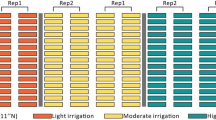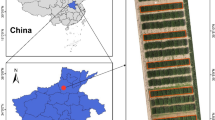Abstract
There is a necessity for new methods and technology for several agricultural applications and decision support systems. Technological development at the global, national, and regional level has shown a path for the application of spaceborne remote sensing for agriculture purposes. Remote sensing technology eases to detect areas within the plots for a reliable data supply to analyze the data. Spaceborne synthetic aperture radar (SAR) data are capable to provide a reliable data supply throughout the year. The global repetition rate is up to 12 days. The datasets acquired from the Sentinel-1 platform facilitates a ground resolution of 20 × 20 m and these sufficient for the synchronization of spaceborne multispectral and radar datasets for enhanced agricultural cropland monitoring applications and decision support systems. Sentinel-1 data is a C-band radar data sets in dual-polarizations. The signal intensity changes over according to humidity in the soil or vegetation cover and the surface structure. The variations in signal information being recovered at the sensor end help in the informed decision making. Besides, SAR datasets are capable to provide information on the phenological stage of agricultural cropland along with crop-type differentiation for specific use cases. The synchronous utilization of spaceborne multispectral and radar datasets for enhanced agricultural cropland monitoring applications and decision support systems can be transformed into informative map products for several processes. The same technology can be beneficial for monitoring crop conditions during any disaster and early warning systems for proper management of available resources.

























Similar content being viewed by others
References
Aher SP, Ph D (2014) Synthetic aperture radar in Indian remote sensing. International journal of applied IIformation Systems(IJAIS) 7(2):2012–2015
Barbosa HA, Huete AR, Baethgen WE (2006) A 20-year study of NDVI variability over the northeast region of Brazil. J Arid Environ 67:288–307
Bassuk NL, Universite AB, Jean M, Universite C, Theoretical L, Politics U et al (2015) On using landscape metrics for landscape similarity search. Landsc Urban Plan 117(1):1–12. https://doi.org/10.1038/srep11160
Benz UC, Hofmann P, Willhauck G, Lingenfelder I, Heynen M (2004) Multi-resolution, object-oriented fuzzy analysis of remote sensing data for GIS-ready information. ISPRS Journal of Photogrammetry and Remote Sensing 58:239–258
Blaschke T, Werner A, Storie CD, Storie J, Hall WD, Alparone L et al (2019) Framework for fusion of ascending and descending. Remote Sens 11(5):1–14. https://doi.org/10.3390/rs11020201
Bolton DK, Friedl MA (2013) Forecasting crop yield using remotely sensed vegetation indices and crop phenology metrics. Agricultural and Forest Meteorology 173:74–84.
Chen X, Zhao H, Li P, Yin Z (2006) Remote sensing image-based analysis of the relationship between urban heat island and land use / cover changes. 104, 133–146. 104:133–146. https://doi.org/10.1016/j.rse.2005.11.016
Dutta D, Kundu A, Patel NR, Saha SK, Siddiqui AR (2015) Assessment of agricultural drought in Rajasthan (India) using remote sensing derived vegetation condition index (VCI) and standardized precipitation index (SPI). Egypt J Remote Sens Space Sci 18(1):53–63. https://doi.org/10.1016/j.ejrs.2015.03.006
Numbisi, F. N., Van Coillie, F., & De Wulf, R. (2019). Delineation of cocoa agroforests using multiseason Sentinel-1 SAR images: a low grey level range reduces uncertainties in GLCM texture-based mapping. ISPRS International Journal of Geo-Information, 8(4), 179.
Fuller DO (1998) Trends in NDVI time series and their relation to rangeland and crop production in Senegal, 1987-1993. International Journal of Remote Sensing, 19(10):2013–2018.
García-León D, Contreras S, Hunink J (2019) Comparison of meteorological and satellite-based drought indices as yield predictors of Spanish cereals. Agric Water Manag 213(October 2018):388–396. https://doi.org/10.1016/j.agwat.2018.10.030
Guzinski R, Nieto H (2019) Evaluating the feasibility of using Sentinel-2 and Sentinel-3 satellites for high-resolution evapotranspiration estimations. Remote Sens Environ 221(October 2018):157–172. https://doi.org/10.1016/j.rse.2018.11.019
Mermoz S, Réjou-Méchain M, Villard L, Le Toan T, Rossi V, Gourlet-Fleury S (2015) Decrease of L-band SAR backscatter with biomass of dense forests. Remote Sens Environ 159:307–317. https://doi.org/10.1016/j.rse.2014.12.019
Michiels P, Gabriels D, Hartmann R (1992) Using the seasonal and temporal precipitation concentration index for characterizing the monthly rainfall distribution in Spain. Catena 19(1):43–58
Mishra D, Singh BN (2019) Derivation of Magnitude of Crop Diversity Through NDVI Composite Index Using Sentinel-2 Satellite Imagery. Journal of the Indian Society of Remote Sensing 47(5):893–906
Morena LC, James KV, Beck J (2004) An introduction to the RADARSAT-2 mission. Canadian Journal of Remote Sensing, 30(3):221–234
Onisi Kirubanandam N, Raju G (2019) Preliminary studies on corner reflectors responses as seen in sentinel-1A images over Kanakapura region. Journal of the Indian Society of Remote Sensing 47(1):25–32. https://doi.org/10.1007/s12524-018-0860-5
Park S, Im J, Jang E, Rhee J (2016) Drought assessment and monitoring through blending of multi-sensor indices using machine learning approaches for different climate regions. Agric For Meteorol 216:157–169. https://doi.org/10.1016/j.agrformet.2015.10.011
Potopová V, Trnka M, Hamouz P, Soukup J, Castraveț T (2020) Statistical modelling of drought-related yield losses using soil moisture-vegetation remote sensing and multiscalar indices in the South-Eastern Europe. Agric Water Manag 236(February):106168. https://doi.org/10.1016/j.agwat.2020.106168
Rahman R, Saha SK (2008) Remote sensing, spatial multi criteria evaluation (SMCE) and analytical hierarchy process (AHP) in optimal cropping pattern planning for a flood prone area. J Spat Sci 53(2):161–177. https://doi.org/10.1080/14498596.2008.9635156
Robock A, Vinnikov KY, Srinivasan G, Entin JK, Hollinger SE, Speranskaya NA, ... Namkhai A (2000) The global soil moisture data bank. Bulletin of the American Meteorological Society, 81(6):1281–1300
Sharman KV, Whitehouse M (1993) Nitrogen drawdown index as a predictor of nitrogen requirements for Nephrolepis in sawdust media. Scientia horticulturae 54(1):23–33
Shastri BP, Haldar D, Mohan S (2015) Temporal monitoring of SAR Polarimetric parameters and scattering mechanism for major Kharif crops and surrounding land use. IJSRSET 1(4):416–424
Soria-Ruiz J, Fernandez-Ordonez Y, McNairn H, Pei-Gee PH (2009) Corn monitoring and crop yield using optical and microwave remote sensing. Geoscience and Remote Sensing 598
Sudha P, Ramprasad V, Nagendra MDV, Kulkarni HD, Ravindranath NH (2007) Development of an agroforestry carbon sequestration project in Khammam district, India. Mitig Adapt Strateg Glob Chang 12(6):1131–1152. https://doi.org/10.1007/s11027-006-9067-0
Tukker A (2015) Product services for a resource-efficient and circular economy - a review. J Clean Prod 97:76–91. https://doi.org/10.1016/j.jclepro.2013.11.049
Kravchenko, A. G., & Thelen, K. D. (2007). Effect of winter wheat crop residue on no‐till corn growth and development. Agronomy Journal, 99(2), 549-555.
Wu W, Pauw ED (2008) A simple algorithm to identify irrigated croplands by remote sensing. (2007), 2006–2008
Zhang F, Chen Y, Zhang J, Guo E, Wang R, Li D (2019) Dynamic drought risk assessment for maize based on crop simulation model and multi-source drought indices. J Clean Prod 233:100–114. https://doi.org/10.1016/j.jclepro.2019.06.051
Zhang XX, Wu PF, Chen B (2010) Relationship between vegetation greenness and urban heat island effect in Beijing City of China. Procedia Environ Sci 2:1438–1450. https://doi.org/10.1016/j.proenv.2010.10.157
Author information
Authors and Affiliations
Corresponding author
Ethics declarations
Conflict of interest
The authors declare that there is no conflict of interests regarding the publication of this paper.
Additional information
Publisher’s note
Springer Nature remains neutral with regard to jurisdictional claims in published maps and institutional affiliations.
Rights and permissions
About this article
Cite this article
Upreti, M., Kumar, D. Investigating capability of open archive multispectral and SAR datasets for Wheat crop monitoring and acreage estimation studies. Earth Sci Inform 14, 2017–2035 (2021). https://doi.org/10.1007/s12145-021-00656-9
Received:
Accepted:
Published:
Issue Date:
DOI: https://doi.org/10.1007/s12145-021-00656-9




